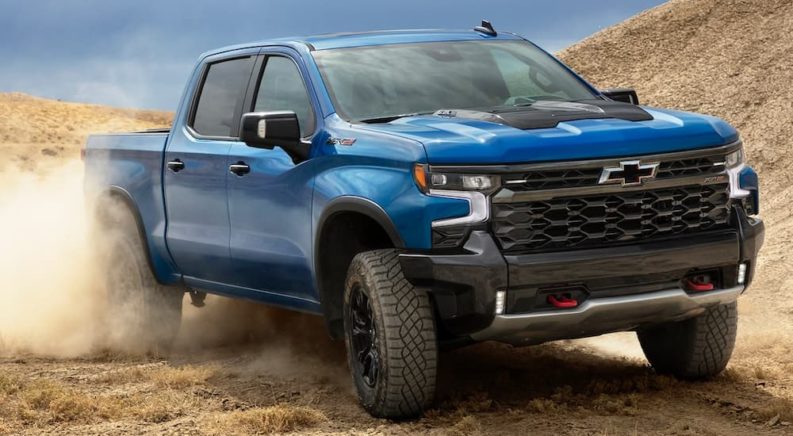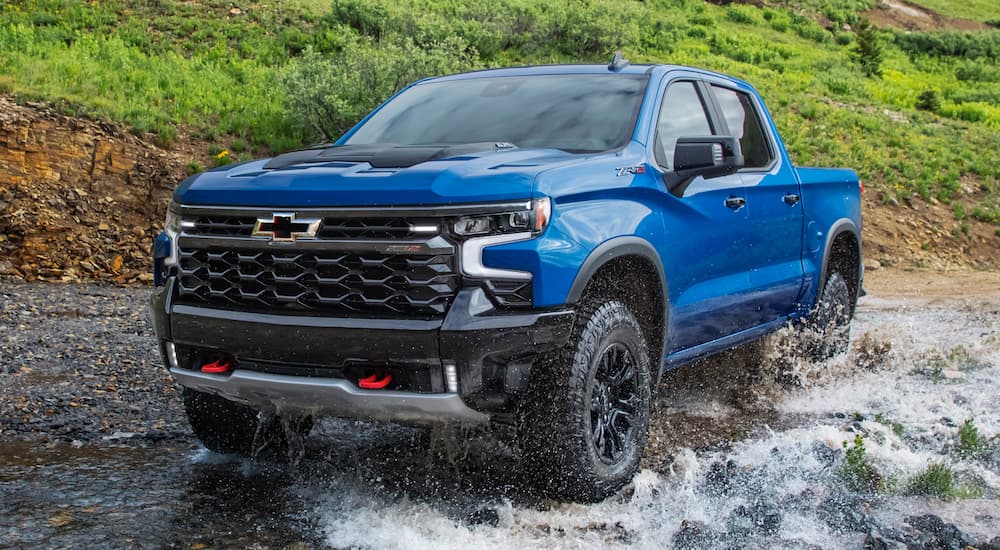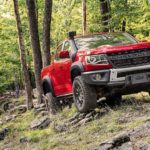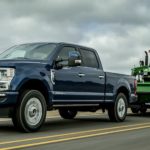How did it take until 2022 for General Motors to finally offer Chevy’s flagship vehicle with their flagship off-road performance package? I mean, sure, they have a well-documented record of dodgy decision-making, but this is a no-brainer. With 60% of Silverado sales currently including either the Trail Boss trim or Z71 package, Chevy dealers nationwide are going to be virtually printing money as soon as the Silverado ZR2 hits their lots.
Of course, this long-overdue pairing might not be as egregious of a miss as one would think. The familiar sound of the ZR2 codename is probably thanks to the legendary Corvette ZR1, Camaro Z28, and Silverado Z71 packages. The ZR2 package hasn’t been around for all that long, relatively speaking, and its mark on history is dominated by its recent revival in the Colorado lineup. In truth, its origins can barely be considered “legendary” at all!
The First ZR2 Was a Baby Truck
Remember the S-Series? No, not that one; Mercedes is still making those. The Chevy one—the pickup truck with enough room for a backpack in the bed and little else. Yes, that’s the one! That’s where the ZR2 story begins! The option was first available in 1994 (a year which is distressingly close to being 30 years ago) on the Chevy S-10 and GMC Sonoma compact pickup trucks. It was built on the same concept as it is today; add a few inches of lift with an upgraded suspension, widen the track a bit, slap honkin’ tires and a bunch of armor on it, et voila! There’s a profound “toddler wearing adult shoes” vibe to the tiny truck with 31” tires on it, so it’s a good thing both the Colorado and Silverado ZR2 feature a significantly modified front fascia in the modern iteration.
The option was extended to the SUV versions of the S-Series platform, the Blazer and Jimmy, and then, in the early ’00s, was even offered on the…Chevy Tracker? Perhaps the only way an off-roader could be smaller than a late model Blazer was by being the Tracker, but hey, they’ve earned their rep with a body-on-frame construction and genuine off-roading chops. These are chops that the ZR2 package enhanced, via…power windows and mirrors, alloy wheels, and all-season tires. Dang.
Sadly, the S-Series met its end in the early aughts, and this gutless Tracker package was the only ZR2 option left. Maybe it’s no surprise, then, that it vanished into history long before the Great Recession turned GM inside-out.
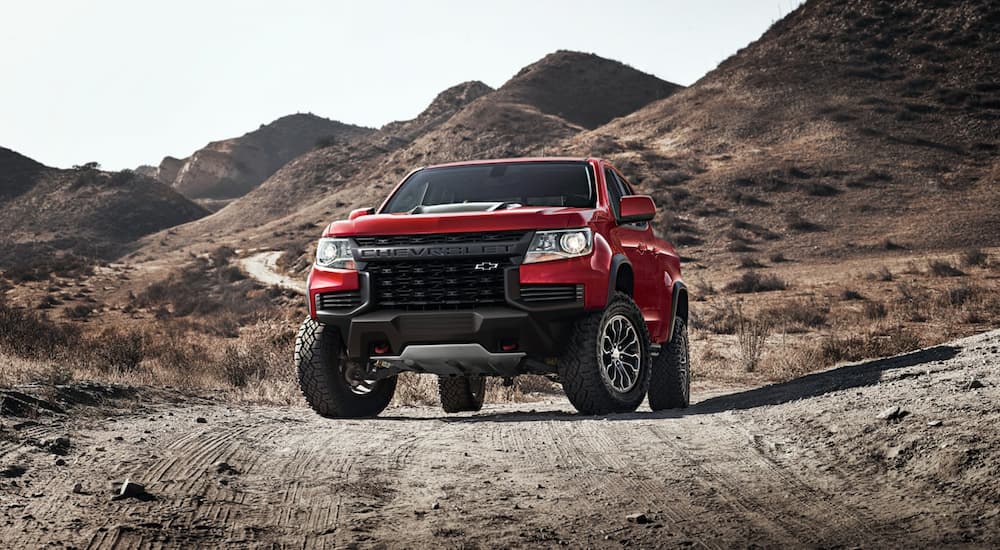
Back Like the Buffalo
By 2005, all production of the Tracker and S-series platforms had ceased, and the ZR2 name had fallen into total dormancy. Its 12-year hibernation did wonders for its complexion, though, because what we got in the 2017 Colorado ZR2 remains a certified off-roading badass today. The revived mid-size truck segment was suffering a dearth of credible off-roaders until the 2020 release of the Jeep Gladiator, so the ZR2 really struck a chord with reviewers, and a collaboration with American Expedition Vehicles, named the Colorado ZR2 Bison, maximizes the package straight from the factory.
The full-size segment had been similarly disinterested in the serious off-roading market, allowing the Ford F-150 Raptor to dominate for years before finally facing a challenge from the new Ram TRX. Unfortunately, we have it on good authority that the Silverado ZR2 doesn’t really compete with those, either. But, it’s in league with the Ram Rebel, Ford Tremor, and Toyota TRD Pro packages—which is fine company for a competitive offering.
Maybe one day, GM will jump the shark and build a 1000 hp Silverado Meteor to bring about the extinction of its Raptor and TRX rivals. But that day is not this day. At least there are currently not one, but two Chevy ZR2 offerings—for the first time since 2004!
Family Resemblance
The Colorado-Silverado relationship is not as simple as “same, but bigger”, and the ZR2 packages for each introduce further complications. But, let’s get the obvious out of the way first:
The Colorado ZR2 is smaller and cheaper. The ZR2 package takes a serious toll on the normally stout Colorado’s load limits, restricting towing to only 5000 lbs and payload to 930-1350 lbs, depending on the engine and equipment packages. Never mind the diesel option; even the gas V6 is more efficient at 16 mpg city/18 highway than the Silverado Trail Boss’s V8 was last year.
Also, its dimensions make it a more comfortable fit in cramped quarters, whether that be an urban home or a narrow trail. It’s 5” narrower, 6” lower, and 20” shorter. $45,000 (or so, MSRPs are all over the place these days) is a lot for a mid-size truck, but the truck you get is as capable as almost anything else.
The Silverado ZR2 is expected to be priced around $70,000, which is a lot more than the Colorado, but hey—you get what you pay for. The 2022 Silverado ZR2 has a heavily refreshed interior—especially compared to the Colorado’s, which has been described as “stale” and cheap-feeling for the price. Silverado’s spacious cabin is a big plus—with rear-seat passengers having at least 8” more leg room and everybody getting 6-7” more shoulder and hip room.
Plus, towing and loading limits (8900 lbs and 1440 lbs respectively) are significantly higher. Fuel efficiency from the 6.2L V8 might be a drag, but 420 hp and 460 lb-ft of torque—compared to the Colorado’s max 308 hp or 369 lb-ft of torque, which come from different engines—is more likely to satisfy in every driving scenario. And let’s face it, this is not a segment that’s ever been deeply concerned with efficiency or towing; it’s about making vehicles that go where no trailer could possibly follow.
Beyond that, some very important details are the same between the two trucks. Electronic locking front and rear differentials are excellent standard tools for escaping hairy situations (and reportedly is a first for the full-size pickup segment). Big ol’ tires (31” and 33” respectively) and a 2 / 2½” lift help with grip and clearance. Supercar-caliber Multimatic DSSV dampers are equipped to provide abnormally good off-road damping without compromising on-road ride comfort. Both even feature exhaust pipe geometry that keeps the entire pipe above the lowest bumper height, shielding it from undue harm and maximizing departure angles.
More Like Cousins Than Brothers
As I mentioned, some differences exist between the two models that aren’t technically necessary. I already addressed the Silverado’s interior as a major point in its favor—the infotainment system, stereo, available HUD, layout, and materials are all from a different era than the Colorado’s. Also, on the subject of styling, the Silverado ZR2’s modern grille includes a Chevy “Flowtie” a la Camaro Z28, where the Colorado ZR2 features a flow-through CHEVROLET stamp. Blacked-out grilles and non-functional but seriously intimidating black hood inserts are a cool common theme, at least, improving the styling continuity across the lineup.
The breakover and departure angles are basically the same for both trucks, at 23.3-23.5°. However, the Silverado ZR2’s front bumper design is such that it has a 31.8° approach angle (better than the Colorado ZR2’s 30°), to go along with 11.2” of ground clearance vs. Colorado ZR2’s 8.9”. And, when not-just-a-scratch bumps inevitably happen, the Silverado ZR2’s front bumper is specifically designed for easy replacement and installation. If the same can be said of the Colorado, GM has yet to mention it out loud.
Among the modern amenities offered on the Silverado ZR2 is Terrain Mode, which was first announced for the GMC Hummer EV. This is a form of one-pedal driving calibrated for low-speed off-road use, where releasing the gas results in enough stopping power to halt the vehicle without ever actually engaging the brake pedal! I am curious about how they implement this on an ICE vehicle, since it’s a hallmark of EV regenerative braking design. However, it works, the 2022 Silverado ZR2 is going to have it, and the 2022 Colorado ZR2 does not.
Something the Colorado has that Silverado doesn’t, though, is the Bison package. Designed and provided from the factory by AEV, the Bison transforms Colorado with huge fender flares and gigantic 35” BF Goodrich tires on beadlock-capable wheels. The axle ratio is upgraded to 4.10 and the truck is fitted with tubular and sheet metal armor, with innovative and thin boron steel sheets providing stronger-yet-lighter and less-intrusive protection than the regular ZR2’s skid plates. Options like a pre-filtered snorkel for improved intake quality and a bumper-integrated Warn winch help finish the transformation into a vehicle that belongs more in the jungle than on the road. While aftermarket support for the Silverado ZR2 will surely be ample, as of the time of writing, there just isn’t an ultimate version of that truck like Bison is for the Colorado.
Rounding Out the Stable
It seems odd that factory-built monster trucks are seeing such a sustained glut of popularity during the age of electrification. But frankly, the Model S is not counted among the list of “go anywhere” vehicles that many parts of the world still want and need for practical, capable transportation. Furthermore, where money is concerned, these types of off-roaders have incredibly low depreciation rates; it’s not uncommon to hear about Ford F-150 Raptors or Jeep Wranglers being sold at nearly the purchase price despite the extra years, miles, and abuse accrued by the interim owner. Their popularity with enthusiasts creates demand and sustains value, and keeping them pristine just isn’t as critical as it is with a sports car. So, it isn’t like the up-front cost is flushed down a drain.
All that being the case, it’s incredible that Chevy took so long to make a Silverado ZR2 that can at least compete with genuine off-road packages like Rebel, Tremor, and TRD Pro. But now, it’s here! Fans of the big Chevy truck will no longer need to compromise on size and capability or rely on aftermarket modifications. It’s new, it’s fresh and it’s completely modernized, which is a big win to most consumers. The only thing missing is a Raptor-equivalent named “Silverado ZR2 Meteor” (remember, you heard it here first!)

